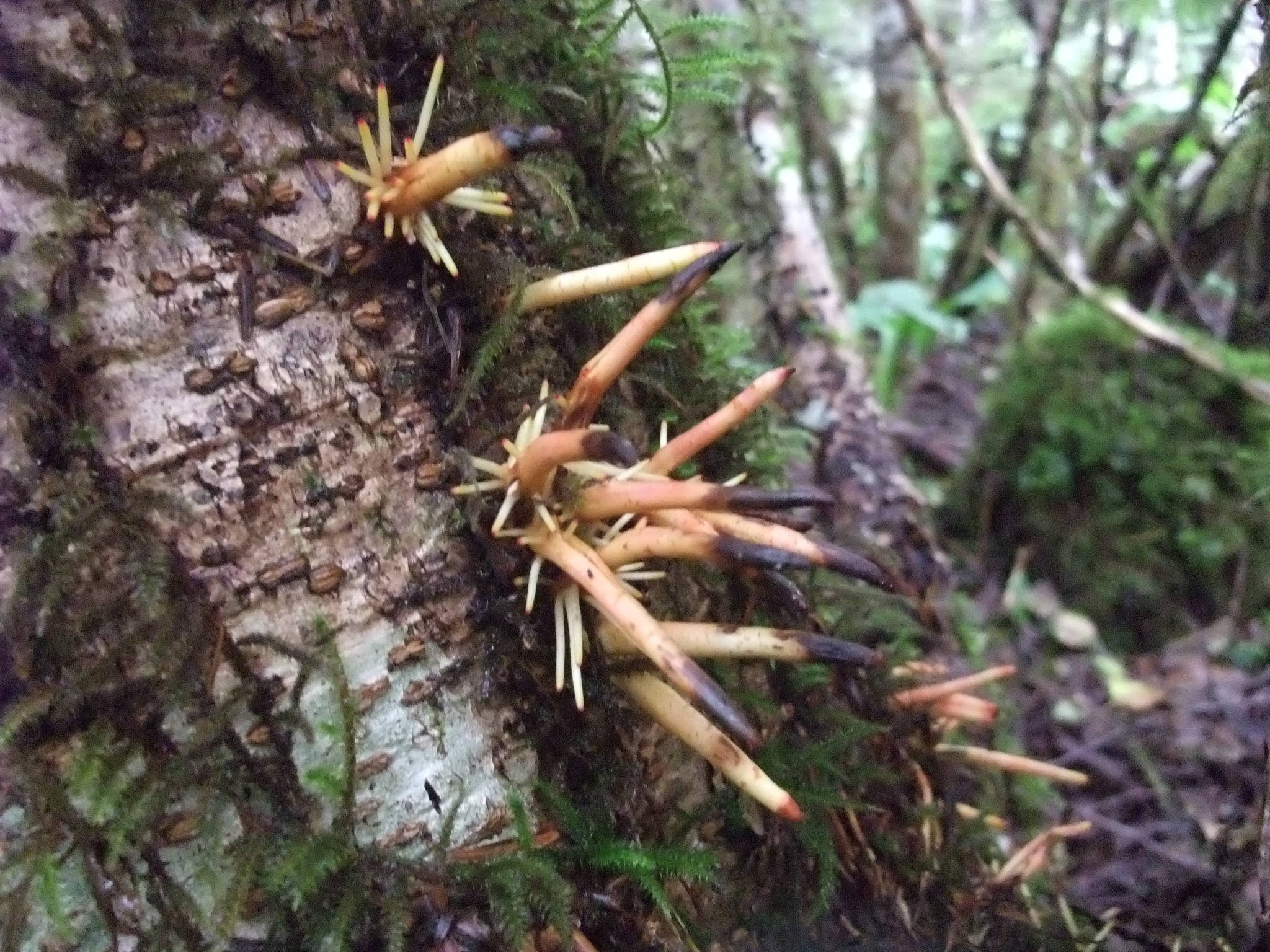One day in mid-August, I wandered along the Eagle River trail, just to where the old Yankee Basin trail branches off up the hill. In that little walk — only about a mile, I found 24 things of special interest; 23 of them were relatively recent bear scats. Of course, I had to check them all out. I learned that, despite the numerous chum salmon carcasses and body parts scattered along the riverbank and the live salmon still thrashing about in the river, the bears had been having a varied diet. Vegetation fibers were a common ingredient, along with some blueberry, devil’s club, and salmonberry. Several scats also contained high-bush cranberries, both seeds and whole, ripe fruits (they are ripening early again this year). Gut passage of whole fruits may not be surprising, given the short length of bear guts, but high-bush cranberries seem to pass through whole more often than other fruits — begging the question “Why?”
The 24th observation was a brownish lump beside the trail, one that moved slightly. When I stopped, the lump became a very young porcupine, busily chowing down on a small plant called enchanter’s nightshade. After watching for a while, I crept by and went on. When I returned, the little fellow was still there, still eating. This time, as I approached, it shuffled off about a foot or two, but came back immediately to the same patch and went on stuffing leaves into its mouth. There were other patches of this common understory plant nearby, only a few feet away, but something made this patch particularly desirable. Was there some other small plant in the mix in that special spot, one that added to the allure?
•••
A stroll with a friend along a beach yielded, among other things, a king crab shell, covered with the characteristic large, robust spines. We wondered about the function of those spikes and guessed that they probably helped defend king crabs from predators. But which predators might be deterred and how do successful predators evade or tolerate the spikes? Apparently, little study has addressed such questions.
•••
A little walk on one of the North Douglas trails discovered some red alder trees with many odd pinkish/orange sprouts coming out of the lower three feet of trunk. These short sprouts were quite stiff, with rounded tips. One trunk had dozens of them. What could they be? Some digging into the scientific literature via the internet and some consultation with another scientist led to the conjecture that these are adventitious root sprouts, but not the conventional type that grow out into soil just above the normal roots of some kinds of trees, in response to flooding. Adventitious root and shoot sprouts (including those that make short leafy shoots on red alder trunks) both grow from meristem tissues (localized growth centers where new cells are formed) that are part of the normal development of the tree trunk but they often stay dormant and don’t break forth from the bark. Red alders have thin bark, which might increase the sensitivity of these growth centers to environmental stimuli, such as light (for leafy shoots) or water (for roots. Similar spiky root sprouts are reported to develop on certain willows too.
A return visit to these same alder trees about two weeks later showed us that most of the pinkish shoots had disappeared. The few remaining ones looked shriveled, woody, and dark. None of them had grown larger than the original two or three inches, so none of them ever became rooted in the ground.
Many questions await answers! Could these odd root sprouts be aerial roots? When sodden soils reduce the amount of oxygen that can reach buried roots, these short shoots might help supply the real roots with oxygen, which is needed for cell respiration and metabolism; they may also help eliminate carbon dioxide, which is one by-product of cell respiration. Why did only a few red alders trees make them, while neighboring alders did not? Are these particular trees growing in a site that has too little oxygen available in the soil (for instance, from saturation with water)? Although the site was damp, it did not seem damper than adjacent places in which neighoboring alders grew without the adventitious roots. Do those particular trees have roots that are damaged in some way, so they have unusual requirements that can be filled by the strange shoots? Or are these particular trees just genetically disposed to be sensitive to certain environmental stimuli such as rain-water streaming down the trunk that might have stimulated the adventitious root sprouts, perhaps on particular, very sensitive, individual trees.
•••
Parks and Rec hikers went up to Cropley Lake one nice day. From the treetops around the open meadows came the clear songs of olive-sided flycatchers: Quick, three beers! Quick, three beers! I often hear them here in the spring, but why would they be singing in late summer when they are about to head south on migration?
•••
On one of the hottest days of the year, when temperatures reached 80 degrees or more, Parks and Rec headed up the Granite Basin trail. Along the trail we found a couple of small stands of the yellow-flowered fireweed, not a common wildflower around here and therefore an unusual pleasure.
A bigger treat was the discovery that a State Parks crew had completed renovations of one section of the trail, making the way smoother and safer. And there were signs that more work is intended — bags of gravel for the muddy areas and stacked boards to replace the worn-out ones. Because this is a favorite trail for many of us, we cheered the State Parks crews.
Thanks to Robin Mulvey (Forestry Sciences Lab) and Ginny Eckert (UAF) for helpful consultation.
• Mary F. Willson is a retired professor of ecology.

